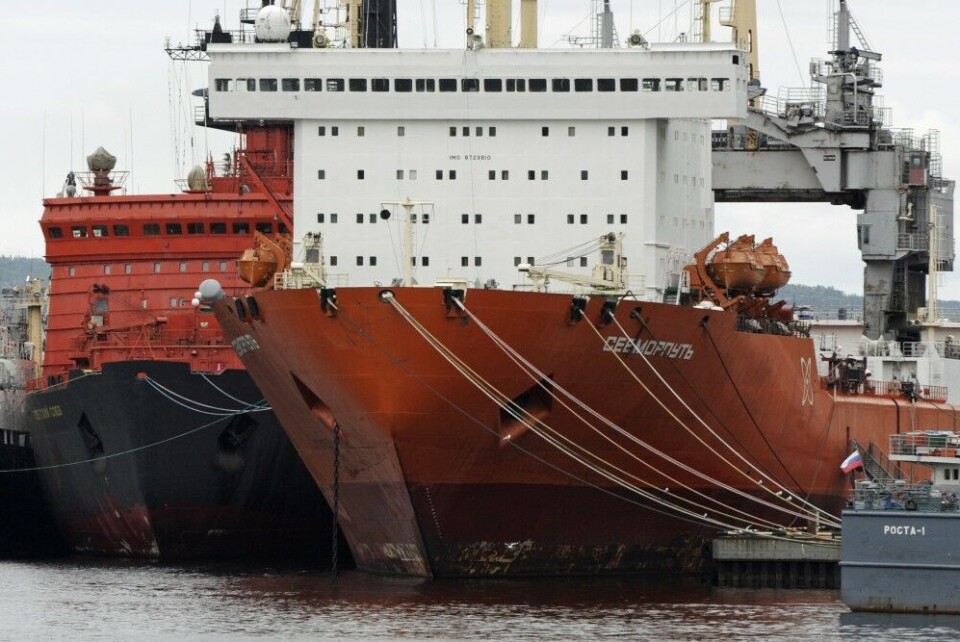
Sevmorput returns to Arctic after troublesome year
The nuclear-powered cargo ship crossed the Arctic Circle at 66°34'N early Tuesday morning.
Currently steaming north along Norway’s northern coast, the “Sevmorput” has expected arrival to Murmansk on Thursday morning this week. It is nearly a year since the ice-strengthened ship last made port-call at its home base in the Kola Bay on Russia’s coast to the Barents Sea.

It has been a troublesome year for what is the world’s only civilian nuclear-powered merchant ship still in operation. Sailing what was supposed to become the first-ever voyage with a nuclear-powered ship to Antarctica, the “Sevmorput” ended up stranded outside Angola for a month last fall.
Onboard were the modules for what will be the expanded Vostok research station.
But the 5,000 tons of facilities for Moscow’s prestigious Antarctica presence didn’t reach the shores at Prydz Bay at the continent during the time-window the southern hemisphere’s summer season made shipping possible. Somewhere in the South-Atlantic, a propeller blade fell off and the “Sevmorput” had to slow down the speed.
Outside the Luanda Bay in West Africa, the voyage ended.
Allowing the 260 meters long, reactor-powered, Russian ship into the central harbor of Luanda was out of the question for Angolan authorities. Repeated attempts were made to repair the propeller with help of divers outside Angola’s 12 nm territorial waters but without success.
By the end of November, the operator of the ship, Rosatomflot, concluded it would not be possible to reach Antarctica before the winter season. “Sevmorput” instead started the long and slowly northbound voyage towards St. Petersburg.
Sailing to Murmansk would be meaningless. The only floating dock up north large enough to facilitate “Sevmorput”, the PD-50 at shipyard No. 82 in Roslyakovo between Murmansk and Severomorsk, sank in October 2018. The dock was then holding the “Admiral Kuznetsov” - Russia’s only aircraft carrier that for the last couple of years has been undergoing repair and upgrade.
Unclear cause
Instead, the “Severmorput” sailed to a shipyard in St. Petersburg where it has been since New Year. With no explanation why it took more than half a year to replace the propeller, Deputy Head of Rosatom and head of the Northern Sea Route Directorate, Vyacheslav Ruksha even says the commission set up to investigate the trouble with the propeller has not yet concluded.
“There are versions, either something got into the propeller, or there was some physical weakness in the metal,” Ruksha said in an interview last week with Kommersant newspaper. The broken propeller was new, installed in early 2020, the Barents Observer previosly reported.
Questions are still many for a ship that is designed to sail in, and break through, a meter think ice along the north coast of Siberia and to Russia’s Arctic archipelagos, like Franz Josef Land.
33-year old
“Sevmorput“ (Russian abbreviation for “Northern Sea Route”) is 33-year old and is powered by a single reactor of the KLT-40 type, similar to the reactor onboard the icebreakers “Taymyr“ and “Vaygach”.
The vessel is well suited to deliver cargo along the north coast of Siberia, where little harbor infrastructure is developed. Sailing in the ice, lighters and other cargo can be unloaded on the ice outside the coast and towed to shore on the ice by trucks or bulldozers. But that wasn’t either a big success in the troubled economic period following the break-up of the Soviet Union. For several periods in the 1990s and 2000s, the ship stayed in port in Murmansk for years without sailing. In 2008, the ship was officially laid up and in 2012 the plan was to scrap it. In 2013, however, it was decided to do renovation and in autumn 2015, the ship was again test-sailing the Barents Sea. The following year, “Sevmorput” was back in regular service and has in the lastest years delivered cargo to military installations in the Russian Arctic, as well as to the petroleum development along the Siberian coast. Equipment has been delivered to the Pavlovsk lead-zink mine development on Novaya Zemlya, and both in 2019 and in 2020, voyages with seafood cargo have taken place between Petropavlovsk in the Far East and St. Petersburg via the Northern Sea Route and around Scandinavia.
The ship can carry 74 lighters or 1324 containers.
After a 2015 upgrade and safety evaluation, the reactor’s service life was prolonged with 150,000 hours aimed at keeping the vessel in operation until 2024.

















